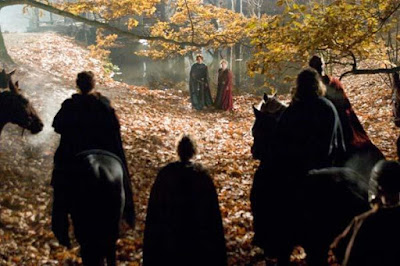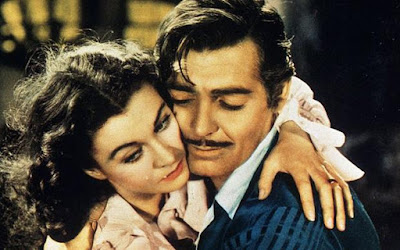Tristan
and Isolde
After the fall of the Roman Empire,
English orphan Tristan meets and falls in love with Irish princess Isolde,
however she is set to marry Lord Marke, who raised Tristan. While unaware of
her identity, he has won her hand in marriage for his lord and future king of
the two countries, but now the passion of the two young people causes a rift
leading to a devastating battle.
***********_______________**********
Tristan
(sometimes called Tristram), the nephew of King Mark of Cornwall, was a symbol
of all the virtues of chivalry, including bravery and honor. Some
accounts also claim that he was a brilliant harp player. According to the most
detailed versions of this legend, the king of Ireland sent a champion named
Morholt to demand tribute from Cornwall, and Tristan fought Morholt in
single combat. Tristan killed Morholt, leaving a broken piece of his sword in the fatal wound. The piece remained
in Morholt's body when it was carried back to Ireland. Morholt had wounded
Tristan as well, and when the wound did not heal, the young knight went to Ireland, in disguise, to seek
help from an Irish princess named Isolde (or Iseult) who was skilled in
healing.
After
Isolde healed Tristan, he lingered at the Irish court for a while. On his
return to Cornwall, he praised Isolde so highly that King Mark resolved to
marry her. Loyal and obedient to his uncle and king, Tristan agreed to return
to Ireland and seek Isolde's hand for Mark.
medieval
relating to the Middle Ages in Europe, a period from about A.D. 500 to 1500
chivalry
rules and customs of
medieval knighthood
tribute
payment made by a
smaller or weaker party to a more powerful one, often under the threat of force
Back
in Ireland, Tristan found that the country was being terrorized by a fearsome
dragon. Tristan succeeded in killing the beast. While Isolde was nursing him
back to health after the fight,
*See
Names and Places at the end of this volume for further information.
she
discovered his broken sword and realized that he was the warrior who had killed
Morholt, her uncle. At first she wanted to avenge her uncle's death. However,
Tristan had endeared himself to the Irish people by killing the dragon, so
Isolde forgave him and agreed to marry King Mark. She set off with Tristan for
Cornwall.
Many
versions of the legend say that Tristan and Isolde had already begun to care
for one another. Their sense of honor might have prevented them from letting
their feelings show, but fate now took a hand. Isolde's mother had prepared a
magical drink for Isolde to share with Mark—a potion that would make them love each other
forever. During the voyage to Cornwall, Isolde and Tristan drank the potion,
not knowing what it was, and fell deeply in love.
Although
Isolde went through with the marriage to Mark, she could not stop loving
Tristan, and he was fated to love her in return. They tried to keep their
passion a secret, but eventually it became known. Some accounts of the story
contain episodes of intrigue and suspense in which King Mark or various knights
try to trap the lovers and obtain proof of their guilt. In the end, Tristan
fled from Cornwall in despair.
By
the 1200s, the legend of Tristan had been interwoven with the Arthurian
legends. Tristan had become a noble knight and appeared in some of the stories
about Arthur, Lancelot, and the knights of the Round Table. By this time,
storytellers had also begun to portray King Mark as cruel or cowardly, perhaps
to create a stronger contrast between Mark and Tristan, though in earlier
versions of the legend, Mark was an honorable man.
Tristan
finally settled in Brittany, where he married another Isolde, known as Isolde
of the White Hands. His love for Isolde of Cornwall had never died, though. In
time Tristan was wounded in battle, and his wife could not cure him. He sent
for Isolde of Cornwall, hoping that she could once again heal him. He requested
that the ship coming back from Cornwall should have white sails if it carried
Isolde and black ones if it did not.
Tristan
lay on his sickbed and waited. Finally the ship appeared on the horizon,
bearing white sails. Too sick to sit up, Tristan asked about the color of the
sails. Jealous of his passion for the first Isolde, his wife lied and said that
they were black. Tristan fell into despair, believing that Isolde had refused
to help him, and died. When Isolde arrived and learned of his death, she too
died of grief. The two were buried in Cornwall. From Isolde's grave a rose tree
grew, and from Tristan's came a vine that wrapped itself around the tree.
Every time the vine was cut, it grew again—a sign that the two lovers could not
be parted in death.
***********_______________**********
Images
The Movie named ,
Tristan + Isolde (2006)
Director:
Kevin ReynoldsWriter:
Dean GeorgarisStars:
James Franco, Sophia Myles, Rufus Sewell
Shakuntala and Dushyant
Perhaps no other faith glorifies the notion of love as Hinduism.
This is evident from the amazing variety of mythical love stories that
abounds Sanskrit literature, which is undoubtedly one of the richest treasure
hoards of exciting love tales.
Classical love legends from Hindu mythology and folklore
of India are both passionate and sensuous in content, and never
fail to appeal to the romantic in us. These fables stretches our imagination,
engage our emotions and, entertain us.
***********_______________**********
The legend of the
exquisitely beautiful Shakuntala and the mighty king Dushyant is a
thrilling love story from the epic Mahabharata, which the great
ancient poet Kalidasa retold in his
immortal play 'Abhijnanashakuntalam'.
While on a hunting trip,
King Dushyant of the Puru dynasty meets the hermit-girl Shakuntala. They fall
in love with each other at first sight and, in the absence of her father,
Shakuntala weds the king in a ceremony of 'Ghandharva'-a form of marriage by
mutual consent with mother Nature as the witness. When the time comes for
Dushyant to return to his palace, he promises to send an envoy to escort her to
his castle.As a fond remembrance he gives her a signet ring.
One day when hermit Durvasa
stops at her hut for hospitality, Shakuntala, lost in her love thoughts, fails
to hear his calls.The temperamental sage turns back and curses her:
"He whose thoughts have engrossed you would not remember you
anymore." On the plea of her companions, the enraged sage relents
and adds a condition to his curse-statement: "He can only recall you upon
producing some significant souvenir."
Days roll by and nobody
from the palace comes to fetch her. Her father sends her to the royal court for
their reunion, as she was pregnant with Dushyant's child. While travelling,
Shakuntala's signet-ring accidentally drops into the river and gets lost.
When Shakuntala presents
herself before the king, Dushyant, under the spell of the curse, fails to
acknowledge her as his wife. Heart-broken, she pleads to the gods for help. The
spell is broken when a fisherman finds the signet ring in the stomach
of a fish - the same ring that Shakuntala had lost on her way to the
court. The king suffers from an intense feeling of guilt and injustice.
Shakuntala forgives Dushyant and they are reunited happily. She gives birth to
a male child. He is called Bharat, after whom India gets her name.
***********_______________**********
Images
The Movie named ,
Shakuntala (1920)
Director:
Suchet SinghWriters:
Kalidasa (play), Suchet SinghStars:
Dorothy Kingdon, Goharjaan, Samson
Scarlett
O'Hara and Rhett Butler
The epic tale of a woman's life during one of the most
tumultuous periods in America's history. From her young, innocent days on a
feudalistic plantation to the war-torn streets of Atlanta; from her first love
whom she has always desired to three husbands; from the utmost luxury to
absolute starvation and poverty; from her innocence to her understanding and
comprehension of life.
***********_______________**********
Scarlett is a
narcissistic plantation belle, the daughter of a French aristocratic mother and
an Irish peasant immigrant who managed to acquire a large cotton plantation and
a lovely cultured wife. Scarlett inherited her mother’s beauty and manners and
her father’s raw energy and ambition. Beneath her polished exterior, she is
dynamo of unruly impulses. Although her beauty and flirtatious behavior have
enslaved almost every young man in the region, Scarlett longs to marry Ashley
Wilkes, the educated son of a distinguished Southern family. Heartbroken when
Ashley marries his cousin Melanie instead, Scarlett marries Melanie’s brother
just to spite Ashley. When her husband is killed in the war, she marries a
store owner for his money, but never abandons her hope of finally winning
Ashley for herself.
Scarlett’s only
real relationship is with Rhett Butler, the dashing young blockade runner who
was disowned by his family and expelled from Charleston for dishonorable
behavior. Rhett sees right through Scarlett’s façade of ladylike elegance and
knows the ruthless, unscrupulous, wildcat which lies behind her pretty face.
Attracted by her energy, strength, courage and beauty, he pursues her first to
become his mistress and later his wife. Scarlett’s heart has always been after
Ashley. She admires Rhett’s brute strength, his courage to defy society, his
tall handsome appearance and his considerable wealth, but she never feels for
him anything like true affection.
But the real love
story in Gone with the Wind is not between these two selfish, self-centered
characters whose passion torments and ultimately ruins the happiness of both.
It is rather the quiet, idealized love between Ashley and Melanie Wilkes that
depicts the true qualities and power of love to nurture, save and protect, even
in times of extraordinary upheaval. Though Scarlett has set her heart on
marrying the refined and cultured Ashley, he chooses instead his mild-mannered
and frail cousin Melanie and marries her. Melanie lacks the captivating beauty,
energy, vitality, and feminine wiles of Scarlett. But her gentle heart is made
of pure goodness and possesses extraordinary power of goodwill that protects
Ashley through the long years of fighting and imprisonment. But Scarlett and
Rhett's turbulent and unfulfilling marriage is marred by constant
quarrels.After the death of their young daughter, Rhett finally leaves her.
Only then does she realize how much she needs and wants him. Through her sobs
in the final scene, Scarlett begins to think of her home Tara, from which she
has always gained strength, and determines that she will return there and will
think of a way to get Rhett back.
***********_______________**********
Images
The Movie named ,
Gone with The Wind (1939)


























































